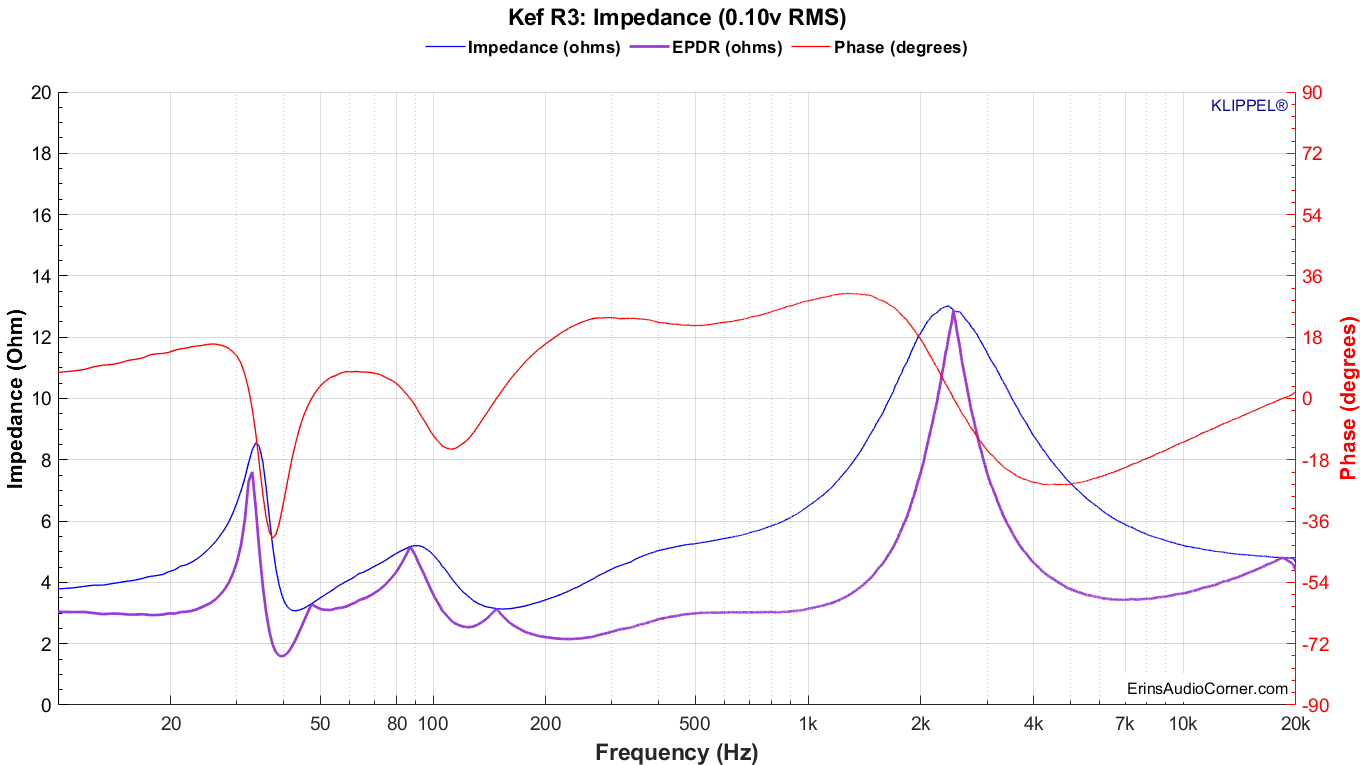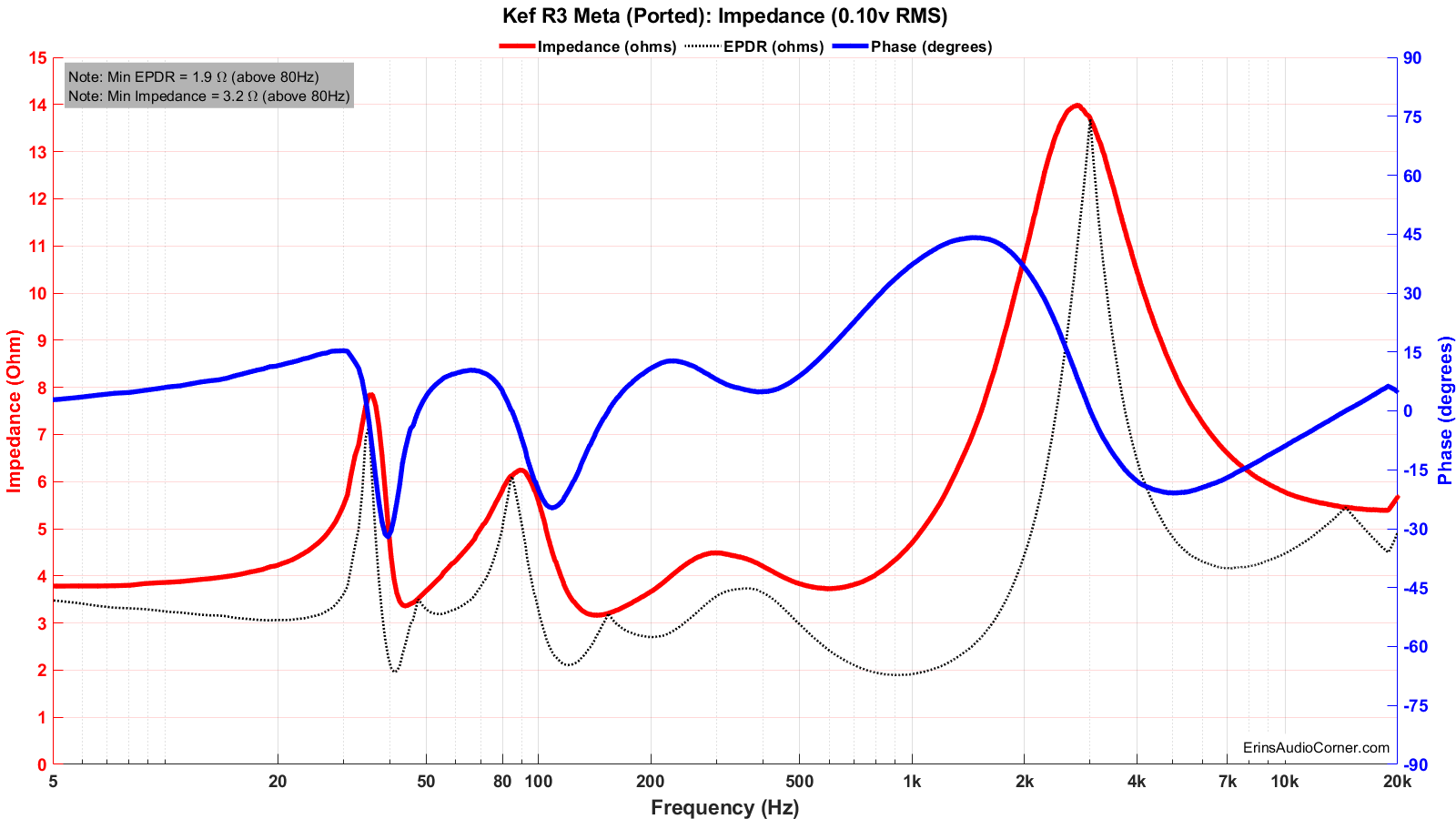-
WANTED: Happy members who like to discuss audio and other topics related to our interest. Desire to learn and share knowledge of science required. There are many reviews of audio hardware and expert members to help answer your questions. Click here to have your audio equipment measured for free!
You are using an out of date browser. It may not display this or other websites correctly.
You should upgrade or use an alternative browser.
You should upgrade or use an alternative browser.
Denon AVR-X3800H Review
- Thread starter amirm
- Start date
You are more than welcome!Thank you for sharing your knowledge so thoroughly! I'll have to read your post another 10 times to commit these concepts to memory. I trimmed the quoted post a bit to highlight a couple things that I need to understand better.
The reason I used 76 dB spl at your listening position is that your KEF R3 (do yo have the meta, or the non meta?)'s sensitivity is 87 dB/2.83V/1m, so at 12 ft, you can use an online calculator: https://sengpielaudio.com/calculator-distance.htmIt took me a bit to understand why you were talking about 2.83v. Ah... 1 watt per how driver sensitivity is measured at 8ohm.
That's just to start with a reference point for you to know how "loud" your speaker can get you with the 2.83 V basis that KEF typically uses. Some manufacturers are still using the 1 W instead of 2.83 V, as you said, that was likely because 2.83 V, applied to an 8 ohm resistor, it will dissipate 1 W. As an EE, who tend to stick with electrical theory when applicable, I don't prefer that format because a) it could, and I am sure it has, confused some hobbyists who are used to think in terms of W, but forgot, or may not realize that sensitivity of 87 dB/2.83V/1m such as the R3, does not equal 87 dB/W/1m. We would have no idea what it would be, because the impedance of the R3 changes with frequency, let allow "resistance". Theoretically, a pure inductive or capacitive load do NOT dissipate watts (W) at all! They do take current, if you apply a voltage to them. The power formula, in its popular simple form is Power (W) = Voltage (V) X Current (A) X COS φ, where COS φ is the cosine of the phase angle between the V and I phasors (often stated as the not so correct "vector").
COS φ is 0, so there is no power dissipation in a pure inductive or capacitive load, though of course in practice, inductors and capacitors will have some resistance, so COS φ wil not not equal 0, but it would be very low for sure.
Using 2.83 V in answering your questions is better, as it will save me not using watts that require impedance and phase angle curves. It will be great to have them, and we do in this case, but it would complicate things a little. The curves for the R3 and R3 meta are available if you want to see them, or if you have not yet.
You can even see the EPDR, another term that is overrated by some forum members, even right here on ASR. I don't particular like that term, though I find it useful. I don't like it only because it could and obviously have, confused many who don't fully understand how it is derived and that one could misunderstand the intended meaning/usage.
For more info, you should go right to the origin and don't take some of the forum talks too seriously:

Heavy Load: How Loudspeakers Torture Amplifiers
Why, in loudspeaker reviews, is impedance measured (assuming that the magazine in question bothers to measure anything)? Generally, for one principal reason only: to establish whether the speaker presents an "easy" or a "difficult" load to its partnering amplifier. In the design context, much...
Also see the author, John Mulcahy of REW's:

Equivalent peak dissipation resistance, EPDR
Back in 2007 Keith Howard proposed a measure he called Equivalent peak dissipation resistance, EPDR, to reflect the way the phase angle of a speaker load increases the peak power dissipation in the output transistors of a power amplifier beyond what might be expected from the load modulus. The...
There's an example of how people could be confused, keep mind John is probably a real genius, but many of us are not lol..
So take a read, he summarized it (and I though I had seen it elsewhere so likely not his own invention...) as:
"The EPDR value is the resistance that would result in the same device peak power dissipation as the speaker load at a given frequency."
Do all people know exactly what that means? I had to think about it before I think I knew what the original writer was trying to say, and does not mean I fully agree with the principles behind. Yet this terms get quoted all over the map on forums, including by a few that I am sure, as it looked obvious to me (though I could be wrong), don't really understand fully what they were talking about.
Regardless, as @dlaloum , one of those who take DPDR seriously, rightfully so, commented, that it depends on the speakers you have, many of them don't really have to be concerned about the DPDR values. You have those KEF speakers, that I think to be on the conservative side, it is a good idea to check out DPDR for them.
Thanks to Erin:


The non Meta one seems less friendly to the lesser amps, that's why I was wondering which one you have.
Another thing side from "depends on which speakers", it could also be true that if the speaker specs say recommended 50 - 200 W, and you have amps rated 250/400 W 8/4 ohms, I would say you don't need to worry about EPDR of the speaker for the obvious reasons, right?
So, that's any reason I feel EPDR is often overrated, on forums, with due respect to Keith Howard, who first introduced this term, as again, I find it useful. Not really necessary for people who knows the EE theories applicable to amps and speakers designs, but a good tool for many none the less.
If you are going to drive with your KEF R speakers with an amp such as buckeyeamp's NC502MP, and someone tells you wait a minute, your R3, may be rated 4 ohms nominal by KEF, but it's DPDR is only 1.8 ohm, you can just say "SO WHAT..."
that to 76dB at my listening distance makes sense. How does this lead to the next reasoning: "To add 20 dB for the peak per THX, you will need 10X the voltage, that is 28.3 V, or 200 W into 4 ohms." Is that referring to how consumer equipment is typically calibrated to a reference level of 75dB + 20dB for dynamic range?
The 20 dB adder is loosely based on THX standard for movies that follow the standard and may have highest peaks up to 20 dB. So if your need 2.83 V to give you 76 dB at you seat, you can calculate/estimate the voltage required to give you 96 dB, without clipping.
Reference level (again per THX for movies) is 85 dB so if that's what you want to listen to, you will need another 9 dB on top of the 76 dB, you calculate the new voltage requirement as follows:
2.83 V is needed for 76 dB at 12 ft, keeping the distance the same at 12 ft, voltage required for 85 dB could be calculated to be about 8 V and that would be about 16 W omtp 4 ohms, and then for the peak of 105 dB, you would need 10X, that is about 80 V, to do a quick check in W, it will be 80*80/4 = 1600 W! That might void your R3's warranty if they know what you might do with such a powerful amp. The buckeyeamp you are considering is only good for about 310 W if want to keep distortions low to stay well below the threshold of audibility (another controversial one but let's not dig into this yet).
You can see that, using the R3 by itself (just 1 speaker making sound), at 12 ft, you can't really get reference level spl of 85 dB average and 105 dB peak without peaking. No point worrying about the so called high current, or EPDR, just get new speakers if you want to listen to reference level. I know you don't listen to reference level, not even close, based on the fact that you seem fine with the AVR-X3800H volume -15.
Yet these speakers are rated at 8ohm with dips below 4ohm. Should these calculations be done at 8ohm instead of 4ohm?
Sort of my point too, but by now, you understand why I would try to stay away from thinking in terms of Watt, but focus on Voltage and Current. All 3 are of course related but if we stick with voltage and current, there should be less confusing, though for people who don't know much about electrical theory then it really doesn't matter.
By the way, the R3 meta are specified as 4 ohms nominal, with minimum dip 3.2 ohms (and about 1.8 ohms minimum if you look at the DPDR). I couldn't find the specs for the non meta R3 but based on Erins measurements, if "watts" are used, I would use 4 ohm nominal to calculate your power requirement and that's why I got 1,600 W required for one single R3 to give you reference level at your seat, if we use KEF's nominal spec then of course you only need 800 W.
Again, why bother with watts, when we can just use voltage and current to figure your amp needs? It of course will work either way though, if you know what you are doing, and have the necessary information.
Really, just knowing that the x3800h can reasonably drive Hypex modules is sufficient for ordering purposes. With how class-d amps have made massive power affordable, the x3800h is a good gateway receiver for those wanting more power now or at a later date. That is, if you're not on a quest to optimize SINAD. Other options are better in that regard. Overall, the x3800h is still an excellent balance of features for me. My aging ears might not even be capable of perceiving distortion at that level.
I really don't see much issue with the AVR-X3800H, it has the same preamp/dac specs as the AVR-X4800 and Cinema 40, it just have lower SINAD than its slightly bigger brother and cousin.
Also keep in mind that the lower SINAD may seem like a lot, vs the brother and cousin, but that's if you compare SINAD for the 1 kHz test. If you compare SINAD with other test signal frequencies, the pictures will get more blurry, just take a look:
Cinema 40:
Using 3 kHz signal, SINAD drop to 65 dB, from 75 dB using 1 kHz!
AVR-X3800H:
The two look very similar, if anything, in this particular test the Denon actually look slightly better, to my eyes anyway.
Last edited:
Peng, I nominate you for a Nobel prize in knowledge sharing.
I now understand that you are doing a more complicated and accurate analysis. Less rigorous discussion, as found most other places online, focuses on calculating watts. Typically, that means figuring out the number of watts needed for the desired dB at your listening position. From there, it is common to back into how many volts are needed from the preamp given an amp's publicized gain. That eliminates a lot of math but has flaws, as you have pointed out.
For the purposes of evaluating amps for use with a x3800h in preamp mode, I'm curious if you think the simplified strategy would produce usable answers? Basically, can the x3800h preamp deliver the required voltage and is there undesirable distortion at that voltage. My scenario is answered, but is the simplified analysis dangerous or inaccurate for others to use?
Thanks for the discussion. I can't wait to put this receiver in preamp mode and enjoy a ton more, clean power!
(Edit: I've got the non-meta R series which are rated at 8ohm. The analysis is still valid though by my reckoning.)
I now understand that you are doing a more complicated and accurate analysis. Less rigorous discussion, as found most other places online, focuses on calculating watts. Typically, that means figuring out the number of watts needed for the desired dB at your listening position. From there, it is common to back into how many volts are needed from the preamp given an amp's publicized gain. That eliminates a lot of math but has flaws, as you have pointed out.
For the purposes of evaluating amps for use with a x3800h in preamp mode, I'm curious if you think the simplified strategy would produce usable answers? Basically, can the x3800h preamp deliver the required voltage and is there undesirable distortion at that voltage. My scenario is answered, but is the simplified analysis dangerous or inaccurate for others to use?
Thanks for the discussion. I can't wait to put this receiver in preamp mode and enjoy a ton more, clean power!
(Edit: I've got the non-meta R series which are rated at 8ohm. The analysis is still valid though by my reckoning.)
Last edited:
Thanks for the nice thoughtPeng, I nominate you for a Nobel prize in knowledge sharing.
True, but not totally... I may have made it a little complicated, but that's because in your first post you said "I had to do considerable reading just to gain enough knowledge to have a productive discussion." So I thought you might be interested in more details than just a yes/no response to your questions.I now understand that you are doing a more complicated and accurate analysis. Less rigorous discussion, as found most other places online, focuses on calculating watts. Typically, that means figuring out the number of watts needed for the desired dB at your listening position. From there, it is common to back into how many volts are needed from the preamp given an amp's publicized gain. That eliminates a lot of math but has flaws, as you have pointed out.
Doing it the way you described, by calculating watts first, will not eliminate the math I used in my response examples. Willing to simply get in the ball park will likely do the trick.
For example, to calculate the watts you would need the following calculations to get the SPL, the R2's spec gives you the 87 dB at 1 meter, you need to know what it will be at your seat, that is 12 ft, or about 3.66 meters.
1) SPL calculations - you have to apply the inverse square law, you can use the calculator, or the formula, both included in the link below:

Distance Attenuation Calculator
The distance attenuation calculator finds how the sound level in dB decreases with distance from the sound source.
Power = Voltage^2/R, and R is, obviously resistance, or the "real" term of the "complex" term of the Impedance (Z). That is phase angle is ignored!!
3) Then you will be at the point where, as you said, go back into how many volts are needed from the preamp, given an amp's publicized gain.
So, again, it really won't eliminate the math. It eliminate the math if you use "rule of the thumb" and/or tables approach, that are widely available on the internet.
Websites I like a lot is the following, because I have found that it has most, if not all formula I need for calculating SPL, Watts, Volts, gain, converting dB to multiples etc.
Decibels to Voltage Gain and Loss convert calculation conversion amplification amplifier electronics - sengpielaudio Sengpiel Berlin
Gain and loss - damping and amplification in dB voltage conversioncalculation amplification amplifier electronics - field parameter - Eberhard Sengpiel sengpielaudio
I would say not in the way you described, but you could probably produce usable answers by taking a different approach that is not often talked about on ASR for some reasons.For the purposes of evaluating amps for use with a x3800h in preamp mode, I'm curious if you think the simplified strategy would produce usable answers? Basically, can the x3800h preamp deliver the required voltage and is there undesirable distortion at that voltage. My scenario is answered, but is the simplified analysis dangerous or inaccurate for others to use?
For example, using your non meta R3's specifications, the recommended power range is 15 - 180 watts
Let's say, just double it and move on!
So you need 360 watts, using the power formula, P = V^2/R, but wait.., the impedance specs say 8 ohms, so what about the minimum, phase angle, or EPDR?\
Okay then let's use rule of the thumb approach and just use 4 ohms (or 3 ohms, 2 ohms, your choice), to calculate the voltage required.
Then V = sqrt(P*R) = sqrt (360*4) = about 39.95 V,
If you use an amp with 26 dB gain, your preamp will need 39.95/(10^(26/20)) = 1.9 V (approx.)
That's much simplified from the other approach I uses previously.
To summarize, the preamp voltage needed depends on the following:
1) Targeted SPL
2) speaker's sensitivity
3) Distance
4) Your acceptation distortions, and/or/both noise levels
If you consider all of the above, the calc/analysis involved will be somewhat calculated, especially if you have speakers such as the R3 (ref: impedance/phase angle curve).
The much simplified approach is to simply based on the speaker manufacturer's recommended "power range", "power requirements", "maximum power handling" kind of specifications, so just picked the "watts" you would like to aim for and then back calculate the preamp voltage, based on the chosen power amp's gain spec. Note: avoid the input sensitivity spec if possible, to minimize potential confusion or ambiguity.
Thanks for the discussion. I can't wait to put this receiver in preamp mode and enjoy a ton more, clean power!
(Edit: I've got the non-meta R series which are rated at 8ohm. The analysis is still valid though by my reckoning.)
Agreed, that "8 ohm nominal" KEF spec seems questionable, given that it's impedance/phase angle vs frequency curve indicate they are as demanding, if not more so, than their meta cousins.
Another minor reason I took the more analytical approach to answer your question is that I anticipate someone would bring up the questions related to EPDR, and/or high current requirements. Such questions are legit, but I have seen some of the posts indicate the posters don't seem to understand the theories behind, they just learn the terms and might turn (unintentionally) them into not too useful buzz words, typically making such useful considerations overrated, sometimes to the nth degree, and may spoil the fun of the owners of great gear, such as the KEF R3. Your case is a good example, you seem happy with the AVR-X3800H driving the R3 that has EPDR 1.8 ohms as long as you stay below volume -15. Lots of people would go lower such as -20 and still find them enjoyable. Those who understand EPDR, or the so called "high current" amp, or high damping factor amps will tell you something about problems with using such as AVR to drive your R3, despite KEF's recommended power range of only 15-150 W and nominal impedance of 8 ohms. They would be partially correct, hence why I used the term "overrated" in those case examples. The thing is, I included more than just throwing out the terms and provide a link or two, to articles of their choices. I just think those posts potentially could mislead, more than help others...but that's just my opinion.
Hey everyone, Where can i find the extra settings for surround upmixers?
I'm hearing that Auro has more options like room size and upmixer strength but I cant find them.
I'm hearing that Auro has more options like room size and upmixer strength but I cant find them.
Hello,
I have a lttle problem with my Denon AVR-X3800H, I have it connected to my TV and my TV connected to my PC, when there is no sound coming out of the source I can hear a white noise coming out of my speakers (ELAC DBR62) and I am sure that before this white noise was not heard, what can I do to erase it?
I have a lttle problem with my Denon AVR-X3800H, I have it connected to my TV and my TV connected to my PC, when there is no sound coming out of the source I can hear a white noise coming out of my speakers (ELAC DBR62) and I am sure that before this white noise was not heard, what can I do to erase it?
Similar threads
- Replies
- 89
- Views
- 8K
- Replies
- 141
- Views
- 52K
- Replies
- 319
- Views
- 67K
- Replies
- 4
- Views
- 1K
- Replies
- 9
- Views
- 1K
